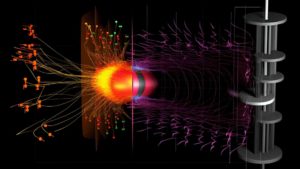The world’s first superconducting flux qubit, which operates ideally under zero magnetic field, has been created, marking a significant advancement in quantum computing. This technology represents a major advancement in the development of more compact and effective quantum computers.
The first superconducting flux qubit in history to operate under zero magnetic fields is a significant advancement in quantum computing technology. It streamlines circuit designs, lowers noise, and has the potential to greatly increase the performance and scalability of quantum computers in the future by doing away with the requirement for external magnetic fields.
According to researchers, We are now one step closer to utilizing quantum computing’s full potential across a range of industries due to this invention.
What Is a Superconducting Flux Qubits?

Unlike conventional computers, quantum computers process complicated data using quantum bits, or qubits. One kind of qubit created with super-conducting materials which, when chilled to extremely low temperatures, have no electrical resistance is called a super-conducting flux qubit.
These changing qubits have historically required an external magnetic field to function properly. To create the magnetic field, large devices like coils are needed. However, the newly created qubit is easier to use in real-world applications because it no longer requires this external magnetic field.
Key Accomplishments of the research

Zero Magnetic Field Operation: An external magnetic field is not necessary for the new flux qubit to function flawlessly. The utilization of a unique ferromagnetic Josephson π-junction is responsible for this. Simply put, this technology eliminates the need for large, external equipment by internally simulating the action of a magnetic field.
Best Coherence Time: Among superconducting qubits using this kind of technology, the new qubit obtained the best coherence time or the amount of time the qubit stays stable. Because the qubits may retain their quantum state for longer, quantum technology computers perform better when the coherence period is longer.
Miniaturization of Quantum Circuit: Quantum computer downsizing is made possible by the qubit’s ability to simplify circuit design and eliminate the requirement for external magnetic field coils. Eventually, stronger and more portable quantum computers will be made possible by smaller quantum circuits.

Nonetheless, What Makes This Significant?
Industries including cybersecurity, materials research, and medicine development are about to undergo a transformation due to quantum computers. Because superconducting flux qubits are easier to operate than other kinds of qubits, they are particularly useful.
However, scaling these systems has been challenging thus far due to the requirement for massive coils and magnetic fields. Many of these problems are resolved by this new flux qubit, which functions without a magnetic field. It increases the process’s effectiveness, controllability, and implementation cost.
What is the Science behind Superconducting flux qubit?

Josephson junctions are utilized in conventional flux qubits to control the flow of electricity inside the qubit. For these junctions to function well, a magnetic field is necessary. The researchers created a unique kind of Josephson junction known as a π-junction to avoid this requirement for a magnetic field.
Without requiring any additional equipment, the π-junction produces the same effect as an external magnetic field. To help the qubit operate at its best at zero magnetic fields, it independently creates a 180-degree phase difference.
Nonetheless, the coherence time of the new flux qubit was 1.45 microseconds. This is the longest coherence time yet recorded for a π-junction superconducting qubit.
Very short coherence periods, sometimes as short as 4 nanoseconds, were obtained in previous studies with several materials. The coherence time of the new qubit is more than 360 times faster than that of earlier superconducting qubits.
With improved materials and designs, π-junction technology could still advance even though existing qubits without the π-junction have even longer coherence periods. The researchers hope to advance this technology even more and eventually beat the qubit systems that are already in use.
Furthermore, the team integrated several advanced technologies to produce this novel flux qubit:
- Niobium Nitride (NbN) Superconducting Qubit Technology: A crucial element was NICT’s superconducting circuit construction technology.
- Tohoku University created the ferromagnetic Josephson devices, which supplied the π-junction required to do away with the requirement for an external magnetic field.
3D Cavity Resonators: The results were confirmed by NTT’s sophisticated qubit measurement and control architecture. - Nonetheless, This innovation of superconducting qubits is just the start. The study team has several objectives and it is certainly not the end.
They aim to Enhance Coherence duration and hope to extend the superconducting qubits stability by upgrading the materials and circuit construction to further extend the coherence duration.
This technology may lead to large-scale quantum computers that can solve extremely complicated problems by making the qubits more efficient and smaller.
The ultimate objective is to develop a new hardware platform for quantum computing that can perform better than existing systems that use qubits made of aluminum.
This search is an incredible benchmark, however, there are still the aims the team wants to achieve for Superconducting quantum technology.













